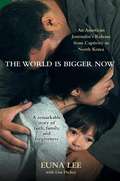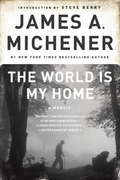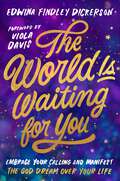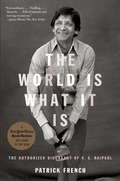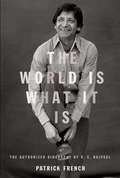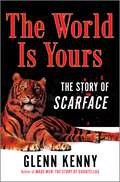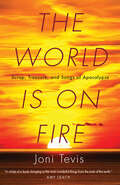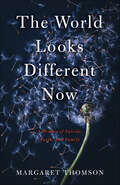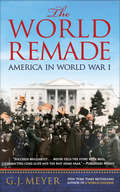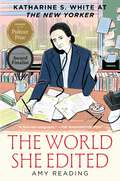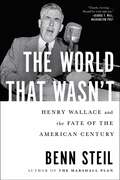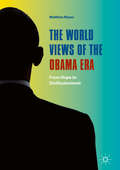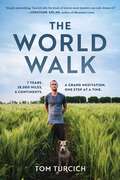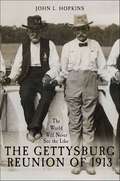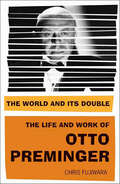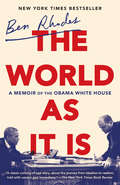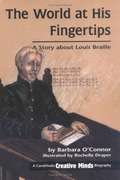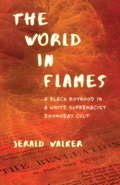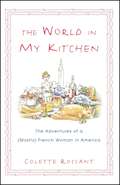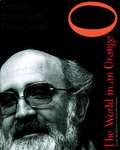- Table View
- List View
The World Is Bigger Now: An American Journalist's Rescue from Captivity in North Korea ... A Remarkable Story of Faith, Family, and Forgiveness
by Lisa Dickey Euna LeeFor the first time, Euna Lee--the young wife, mother, and film editor detained in North Korea--tells a harrowing, but ultimately inspiring, story of survival and faith in one of the most isolated parts of the world. On March 17, 2009, Lee and her Current TV colleague Laura Ling were working on a documentary about the desperate lives of North Koreans fleeing their homeland for a chance at freedom when they were violently apprehended by North Korean soldiers. For nearly five months they remained detained while friends and family in the United States were given little information about their status or conditions. For Lee, detention would prove especially harrowing. Imprisoned just 112 miles from where she was born and where her parents still live in Seoul, South Korea, she was branded as a betrayer of her Korean blood by her North Korean captors. After representing herself in her trial before North Korea's highest court, she received a sentence of twelve years of hard labor in the country's notorious prison camps, leading her to fear she might not ever see her husband and daughter again.The World Is Bigger Now draws us deep into Euna Lee's life before and after this experience: what led to her arrival in North Korea, her efforts to survive the agonizing months of detainment, and how she and her fellow captive, Ling, were finally released thanks to the efforts of many individuals, including Bill Clinton. Lee explains in unforgettable detail what it was like to lose, and then miraculously regain, life as she knew it.The World Is Bigger Now is the story of faith and love and Euna Lee's personalconviction that God will sustain and protect us, even in our darkest hours.From the Hardcover edition.
The World Is My Home
by James A. MichenerIn this exceptional memoir, the man himself tells the story of his remarkable life and describes the people, events, and ideas that shaped it. Moving backward and forward across time, he writes about the many strands of his experience: his passion for travel; his lifelong infatuation with literature, music, and painting; his adventures in politics; and the hard work, headaches, and rewards of the writing life. Here at last is the real James Michener: plainspoken, wise, and enormously sympathetic, a man who could truly say, "The world is my home." BONUS: This edition includes an excerpt from James A. Michener's Poland.
The World Is Waiting for You: Embrace Your Calling and Manifest the God Dream Over Your Life
by Edwina Findley DickersonWith a foreword by Viola Davis, award-winning actress Edwina Findley Dickerson presents a faith-filled, laugh-out-loud guide for manifesting your “God Dream” and creating the life you’ve always envisioned.Were you born with a talent, and gifting to change the world? Is there a divine calling and awe-inspiring “God Dream” over your life that’s higher than your wildest imagination? What is the secret to discovering this grand vision, and supernaturally manifesting it here on earth?The World Is Waiting for You takes takes you on a humorous faith-filled ride, sharing incredible supernatural stories of how God radically manifested His divine dream for Edwina’s life, and how you can manifest the fullest expression of your purpose and calling.From living in poverty in her twenties to becoming a millionaire in her thirties, Edwina shares hard-won wisdom regarding unleashing your highest vision, discovering and surrendering to God’s plan, strategically preparing for the life you are praying for, developing a passion for service, and making bold faith-moves in the manifestation of your “God Dream.”Through spiritual insights, practical strategies, and revelations from other celebrities and faith leaders, The World Is Waiting for You, will guide you along the incredible path of discovering and fulfilling your divine purpose, and overcoming the road blocks that stand in the way. With a special focus on using your gifts to positively impact others, this book is interactive and will help you tap into the supernatural “God Dream” that is assigned to your life, and unleash the faith, tenacity and confidence to make that divine vision a reality.
The World Is What It Is
by Patrick FrenchThe first major biography of V.S. Naipaul, the controversial and enigmatic Nobel laureate: a stunning writer whose only stated ambition was greatness, in pursuit of which goal nothing else was sacred. Beginning in rich detail in Trinidad, where Naipaul was born into an Indian family, Patrick French skillfully examines Naipaul's life within a displaced community and his fierce ambition at school. He describes how, on scholarship at Oxford, homesickness and depression struck with great force; the ways in which Naipaul's first wife helped him to cope and their otherwise fraught marriage; and Naipaul's struggles throughout subsequent uncertainties in England, including his twenty-five-year-long affair.Naipaul's extraordinary gift--producing, uniquely, masterpieces of both fiction and nonfiction--is most of all born of a forceful, visionary impulse, whose roots French traces with a sympathetic brilliance and devastating insight.From the Trade Paperback edition.
The World Is What It Is: The Authorized Biography of V. S. Naipaul
by Patrick FrenchV.S. Naipaul's biographer aims not to sit in judgment of the Nobel laureate, but to expose the subject with ruthless clarity to the calm eye of the reader. In this he succeeds admirably. Descendant of poor Brahmins, born in 1932 in Trinidad and educated in Oxford, Naipaul is haunted by matters of race, colonialism and sex. He is, says award-winning author French (Younghusband), both the racist (against those darker than he) and the victim of racial prejudice, tendencies that come through in his novels and in his treatment of friends and lovers. Haunting this biography are Naipaul's women. His wife, Pat, supported him, overlooked his affairs and his visits with prostitutes, and subordinated herself to his genius; Naipaul gave equally little to Margaret, his mistress.
The World Is Yours: The Story of Scarface
by Glenn KennyThe behind-the-scenes story of the iconic film Scarface, featuring new interviews with the cast and crew. An unflinching confrontation of humanity&’s dark side, Brian De Palma&’s crime drama film Scarface gave rise to a cultural revolution upon its release in 1983. Its impact was unprecedented, making globe-spanning waves as a defining portrait of the gritty Miami street life. From Al Pacino&’s masterful characterization of Tony Montana to the iconic &“Say hello to my little friend,&” Scarface maintains its reputation as an unwavering game changer in cult classic cinema. With brand-new interviews and untold stories of the film&’s production, longtime film critic Glenn Kenny takes us on an unparalleled journey through the making of American depictions of crime. The World Is Yours highlights the influential characters and themes within Scarface, reflecting on how its storied legacy played such a major role in American culture.
The World Is on Fire: Scrap, Treasure, and Songs of Apocalypse
by Joni TevisThis “magnificently compelling” essay collection explores obsession, anxiety, and Existential dread from the Book of Revelation to the Liberace Museum (Minneapolis Star Tribune).The sermons of Joni Tevis’ youth filled her with dread, a sense “that an even worse story—one you hadn’t read yet—could likewise come true.” In this revelatory collection, she reckons with her childhood fears by exploring the uniquely American fascination with apocalypse. From a haunted widow’s wildly expanding mansion, to atomic test sites in the Nevada desert, her settings are often places of destruction and loss.And yet Tevis transforms these eerie destinations into sites of creation as well, uncovering powerful points of connection. Whether she’s relating her experience of motherhood or describing the timbre of Freddy Mercury’s voice in “Somebody to Love,” she relies on the same reverence for detail and sense of awe. And by anchoring her attention to the raw materials of our world—nails and beams, dirt and stone, bones and blood—she discovers grandeur in the seemingly mundane.Winner of the 2016 Firecracker Award for Creative NonfictionFinalist for the 2016 Pat Conroy Southern Book Prize
The World Looks Different Now: A Memoir of Suicide, Faith, and Family
by Margaret ThomsonOn a glorious, if blisteringly hot, Saturday in August 2010, Margaret Thomson’s world is suddenly shattered by the incomprehensible news that her twenty-two-year-old son, a medic in the army, has taken his life.In a deep state of shock, Thomson and her husband immediately travel to Fort Bragg, North Carolina, where their son Kieran was stationed, in an effort to assist their daughter-in-law. Upon their arrival, though, the couple find themselves plunged into a labyrinthine and, at times, seemingly bizarre world of military rules and regulations.Eventually, after the funeral and the memorial services are over, an even more challenging journey—emotionally as well as geographically—ensues, especially for Margaret, who, as a former journalist, is determined to find out more about the circumstances surrounding her son’s death, no matter how high the cost.As she enters her second year of grieving, Thomson receives an unexpected invitation from an unlikely source—the army, which she’s often blamed in many ways, whether fairly or not, for her son’s death. Seizing upon this opportunity, Thomson finds that her perspective is changed—literally—and that as a result the world does indeed look different now.
The World Remade: America in World War I
by G. J. MeyerA bracing, indispensable account of America’s epoch-defining involvement in the Great War, rich with fresh insights into the key issues, events, and personalities of the period After years of bitter debate, the United States declared war on Imperial Germany on April 6, 1917, plunging the country into the savage European conflict that would redraw the map of the continent—and the globe. The World Remade is an engrossing chronicle of America’s pivotal, still controversial intervention into World War I, encompassing the tumultuous politics and towering historical figures that defined the era and forged the future. When it declared war, the United States was the youngest of the major powers and militarily the weakest by far. On November 11, 1918, when the fighting stopped, it was not only the richest country on earth but the mightiest. With the mercurial, autocratic President Woodrow Wilson as a primary focus, G. J. Meyer takes readers from the heated deliberations over U.S. involvement, through the provocations and manipulations that drew us into the fight, to the battlefield itself and the shattering aftermath of the struggle. America’s entry into the Great War helped make possible the defeat of Germany that had eluded Britain, France, Russia, and Italy in three and a half years of horrendous carnage. Victory, in turn, led to a peace treaty so ill-conceived, so vindictive, that the world was put on the road to an even bloodier confrontation a mere twenty years later. On the home front, Meyer recounts the break-up of traditional class structures, the rise of the progressive and labor movements, the wave of anti-German hysteria, and the explosive expansion of both the economy and federal power, including shocking suspensions of constitutional protections that planted the seeds of today’s national security state. Here also are revealing portraits of Theodore Roosevelt, Henry Cabot Lodge, Robert La Follette, Eugene Debs, and John J. “Black Jack” Pershing, among others, as well as European leaders such as “Welsh Wizard” David Lloyd George of Britain, “Tiger” Georges Clemenceau of France, and Kaiser Wilhelm II of Germany. Meyer interweaves the many strands of his story into a gripping narrative that casts new light on one of the darkest, most forgotten corners of U.S. history. In the grand tradition of his earlier work A World Undone—which centered on the European perspective—The World Remade adds a new, uniquely American dimension to our understanding of the seminal conflict of the twentieth century.
The World She Edited: Katharine S. White at The New Yorker
by Amy ReadingFinalist for the Pulitzer PrizeFinalist for the National Book Critics Circle Award"Meticulously researched." —The New York Times "A first-rate biography." —Washington PostA lively and intimate biography of trailblazing and era-defining New Yorker editor Katharine S. White, who helped build the magazine’s prestigious legacy and transform the 20th century literary landscape for women.In the summer of 1925, Katharine Sergeant Angell White walked into The New Yorker’s midtown office and left with a job as an editor. The magazine was only a few months old. Over the next thirty-six years, White would transform the publication into a literary powerhouse.This exquisite biography brings to life the remarkable relationships White fostered with her writers and how these relationships nurtured an astonishing array of literary talent. She edited a young John Updike, to whom she sent seventeen rejections before a single acceptance, as well as Vladimir Nabokov, with whom she fought incessantly, urging that he drop needlessly obscure, confusing words.White’s biggest contribution, however, was her cultivation of women writers whose careers were made at The New Yorker—Janet Flanner, Mary McCarthy, Elizabeth Bishop, Jean Stafford, Nadine Gordimer, Elizabeth Taylor, Emily Hahn, Kay Boyle, and more. She cleared their mental and financial obstacles, introduced them to each other, and helped them create now classic stories and essays. She propelled these women to great literary heights and, in the process, reinvented the role of the editor, transforming the relationship to be not just a way to improve a writer’s work but also their life.Based on years of scrupulous research, acclaimed author Amy Reading creates a rare and deeply intimate portrait of a prolific editor—through both her incredible tenure at The New Yorker, and her famous marriage to E.B. White—and reveals how she transformed our understanding of literary culture and community.“The next best thing to cocktails at the Algonquin.” — Heather Clark, author of Red Comet: The Short Life and Blazing Art of Sylvia Plath
The World That Wasn't: Henry Wallace and the Fate of the American Century
by Benn SteilFrom the acclaimed economist-historian and author of The Marshall Plan comes a dramatic and powerful new perspective on the political career of Henry Wallace—a perspective that will forever change how we view the making of US and Soviet foreign policy at the dawn of the Cold War.Henry Wallace is the most important, and certainly the most fascinating, almost-president in American history. As FDR&’s third-term vice president, and a hero to many progressives, he lost his place on the 1944 Democratic ticket in a wild open convention, as a result of which Harry Truman became president on FDR&’s death. Books, films, and even plays have since portrayed the circumstances surrounding Wallace&’s defeat as corrupt, and the results catastrophic. Filmmaker Oliver Stone, among others, has claimed that Wallace&’s loss ushered in four decades of devastating and unnecessary Cold War. Now, based on striking new finds from Russian, FBI, and other archives, Benn Steil&’s The World That Wasn&’t paints a decidedly less heroic portrait of the man, of the events surrounding his fall, and of the world that might have been under his presidency. Though a brilliant geneticist, Henry Wallace was a self-obsessed political figure, blind to the manipulations of aides—many of whom were Soviet agents and assets. From 1933 to 1949, Wallace undertook a series of remarkable interventions abroad, each aimed at remaking the world order according to his evolving spiritual blueprint. As agriculture secretary, he fell under the spell of Russian mystics, and used the cover of a plant-gathering mission to aid their doomed effort to forge a new theocratic state in Central Asia. As vice president, he toured a Potemkin Siberian continent, guided by undercover Soviet security and intelligence officials who hid labor camps and concealed prisoners. He then wrote a book, together with an American NKGB journalist source, hailing the region&’s renaissance under Bolshevik leadership. In China, the Soviets uncovered his private efforts to coax concessions to Moscow from Chiang Kai-shek, fueling their ambitions to dominate Manchuria. Running for president in 1948, he colluded with Stalin to undermine his government&’s foreign policy, allowing the dictator to edit his most important election speech. It was not until 1950 that he began to acknowledge his misapprehensions regarding the Kremlin&’s aims and conduct. Meticulously researched and deftly written, The World That Wasn&’t is a spellbinding work of political biography and narrative history that will upend how we see the making of the early Cold War.
The World Views of the Obama Era
by Matthias MaassThis book presents selected non-US views of the Barack Obama administration. Each chapter investigates eight years of the Obama presidency from a different national perspective. By bringing together fourteen country studies from all regions of the world, this volume offers an accumulative global view of the Obama White House's foreign policies and bilateral affairs. It provides an outside perspective on a presidency that was initially greeted with much enthusiasm world-wide, but seemed to fall out of favor over time in most countries. The overwhelming hope that was associated with the election of Obama in 2008 turned to disillusionment world-wide; the changes in US external affairs he promised were only partially fulfilled and the world was reminded that America's place and role in the world would not change dramatically, not even under the inspirational Obama.
The World Walk: 7 Years. 28,000 Miles. 6 Continents. A Grand Meditation, One Step at a Time.
by Tom TurcichThe invigorating true story of a man and his dog who circled the globe on foot."Quietly stunning." —Laurie Woolever, New York Times bestselling author of World Travel with Anthony Bourdain and Bourdain: The Definitive Oral Biography After the death of a close friend at seventeen, Tom Turcich resolved to make the most out of life; to travel and be forced into adventure; to experience and understand the world. On April 2nd, 2015, he set out to see it all—one step at a time.The World Walk is the emotional and exhilarating story of the tenth person and first dog to walk around the world. Together, Turcich and his dog, Savannah, covered twenty-eight thousand miles over the course of seven years. Through deserts, jungles, cities, and mountains, Turcich meditated on what&’s important in life and took lessons from cultures around the globe. Rarely has there been a true-life tale of such scope. From sheltered suburbanite to world traveler, Turcich&’s epic account runs the full gamut: He is held up at knifepoint in Panama and gunpoint in Turkey; wanders deep within himself in the deserts of Peru; watches a democracy fortify itself in Georgia; and takes it all in with his resolute companion by his side. His growth spans the most basic elements of surviving on the road—finding food, water, and safe places to camp—to humanity&’s more noble aspirations, such as the benefits of democracy, the search for love, and the weighing of personal significance. Accompanied by some of the author&’s world-class photography, this tour de force of resilience and triumph of the human spirit will reaffirm to readers that the world is beautiful, people are good, and life should be a generous, vibrant adventure.
The World Will Never See the Like: The Gettysburg Reunion of 1913
by John L. Hopkins“In this groundbreaking study, author John L. Hopkins deftly examines the reunion through the lens of the veterans within the context of society, politics, and the national mood at the time.” — Scott L. Mingus Sr., author of Flames Beyond Gettysburg and co-author of If We Are Striking for Pennsylvania, Vols. 1 and 2 The largest gathering of Union and Confederate veterans ever held was front-page news throughout the country. “[It] will be talked about and written about as long as the American people boast of the dauntless courage of Gettysburg,” declared a woman who accompanied her father to the reunion. But as the years passed, the memorable event was all but forgotten. John Hopkins’s The World Will Never See the Like: The Gettysburg Reunion of 1913 goes a long way toward making sure the world will remember. The 1913 Gettysburg reunion is a story of 53,000 old comrades and former foes reunited, and of the tension, even half a century later, between competing narratives of reconciliation and remembrance. For seven days the old soldiers lived under canvas in stifling heat on a 280-acre encampment run by the U.S. Army. They swapped stories, debated still-simmering controversies about the battle, and fed tall tales to gullible reporters. On July 3, the aging survivors of Pickett’s Division and the Philadelphia Brigade shook hands across the wall on Cemetery Ridge in the reunion’s climactic photo op. Some of the battle’s leading personalities attended, including Union III Corps commander Dan Sickles, who at 92 was still eager to explain to anyone who would listen the indispensable role he claimed to have played in the Union victory. Also present was Helen Dortch Longstreet, the widow of Confederate Lt. Gen. James Longstreet, who devoted her life and considerable energies to defending the reputation of her general. Both wrote articles from the reunion that were syndicated in newspapers across the country. There was even a cameo appearance by a young and as-yet unknown cavalry officer named George S. Patton Jr. Hopkins fills his marvelous account with detail from the letters, diaries, and published accounts of Union and Confederate veterans, the extensive archival records of the reunion’s organizers, and the daily stories filed by the scores of reporters who covered it. The World Will Never See the Like offers the first full story of this extraordinary event’s genesis and planning, the obstacles overcome on the way to making it a reality, its place in the larger narrative of sectional reunion and reconciliation, and the individual stories of the veterans who attended. Every reader interested in Gettysburg will find this a welcome addition to their library.
The World and Its Double: The Life and Work of Otto Preminger
by Chris FujiwaraOtto Preminger was one of Hollywood's first truly independent producer/directors. He sought to address the major social, political, and historical questions of his time in films designed to appeal to a wide public. Blazing a trail in the examination of controversial issues such as drug addiction (The Man with the Golden Arm) and homosexuality (Advise and Consent) and in the frank, sophisticated treatment of adult material (Anatomy of a Murder), Preminger in the process broke the censorship of the Hollywood Production Code and the blacklist. He also made some of Hollywood's most enduring film noir classics, including Laura and Fallen Angel.An Austrian émigré, Preminger began his Hollywood career in 1936 as a contract director. When the conditions emerged that led to the fall of the studio system, he had the insight to perceive them clearly and the boldness to take advantage of them, turning himself into one of America's most powerful filmmakers. More than anyone else, Preminger represented the transition from the Hollywod of the studios to the decentralized, wheeling and dealing New Hollywood of today. Chris Fujiwara's critical biography--the first in more than thirty years--follows Preminger throughout his varied career, penetrating his carefully constructed public persona and revealing the many layers of his work.
The World and Richard Nixon
by C. L. SulzbergerFormer New York Times foreign correspondent C.L. Sulzberger reviews Nixon's president specifically from a foreign affairs perspective.
The World and the Bo Tree
by Helen Bevington"Each time I leave home I seem to go in search of something--call it a bo tree, or Shangri-La, or paradise--which is only another name for peace itself and these days decidedly a fool's errand."So writes Helen Bevington in The World and the Bo Tree, a book that describes her travels taken amid the turbulence of the 1980s. The "world" of the title is the one everybody knows, a fairly troubled, even threatening place to inhabit these days. The bo tree, which has flourished for centuries in India and Asia, is itself a meaningful symbol of peace, since under it the Buddha sat when he gained enlightenment and sought thereafter to share it with the world.The book fashions a delightful fabric, a weave of exotic journeys and chaotic recent history. While we travel with Bevington to and from various destinations in Europe, Asia, South America, Africa, China, and elsewhere, we are conscious of the look of the world at home in striking contrast to the serenity occasionally glimpsed in distant places. At home she reminds us of such global disturbances as the demise of the Equal Rights Amendment, the Chernobyl nuclear disaster, the explosion of the space shuttle Challenger, and the possible destruction of the planet. Abroad, on some quest of their own, we may encounter such fascinating passersby as Mark Twain in Bangkok, Lord Byron in Italy, Goethe in Sicily, Marco Polo in China, Isak Dinesen in Africa, and Gladstone in the Blue Grotto of Capri.Against the backdrop of the world, Bevington discovers moments of peace in unexpected and unlikely places--visible, she says, in Tibet or on the road to Mandalay, in the look of the midnight sun, or in the silence of Africa. Fleeting and elusive though these moments are, they are real and in themselves strangely enlightening.
The World as I Have Found It
by Mary L. Day ArmsA graduate of the Maryland Institution for the Blind, Mary L. Day published a memoir in 1859 entitled Incidents in the Life of a Blind Girl. In this book, a sequel to her first, she recounts how she traveled throughout the country earning a living through the sale of her memoir. She also writes about meeting her future husband, visiting places of interest, and having numerous adventures on the road. The book closes with several essays on blindness and the education of the blind and with a collection of poems by blind authors.
The World as It Is: A Memoir of the Obama White House
by Ben RhodesFrom one of Barack Obama’s closest aides comes a revelatory behind-the-scenes account of his presidency—and how idealism can confront harsh reality and still survive—in the tradition of Arthur Schlesinger, Jr.’s A Thousand Days: John F. Kennedy in the White House. <P><P>For nearly ten years, Ben Rhodes saw almost everything that happened at the center of the Obama administration—first as a speechwriter, then as deputy national security advisor, and finally as a multipurpose aide and close collaborator. He started every morning in the Oval Office with the President’s Daily Briefing, traveled the world with Obama, and was at the center of some of the most consequential and controversial moments of the presidency. <P>Now he tells the full story of his partnership—and, ultimately, friendship—with a man who also happened to be a historic president of the United States. Rhodes was not your typical presidential confidant, and this is not your typical White House memoir. <P><P>Rendered in vivid, novelistic detail by someone who was a writer before he was a staffer, this is a rare look inside the most poignant, tense, and consequential moments of the Obama presidency—waiting out the bin Laden raid in the Situation Room, responding to the Arab Spring, reaching a nuclear agreement with Iran, leading secret negotiations with the Cuban government to normalize relations, and confronting the resurgence of nationalism and nativism that culminated in the election of Donald Trump. <P>In The World as It Is, Rhodes shows what it was like to be there—from the early days of the Obama campaign to the final hours of the presidency. It is a story populated by such characters as Susan Rice, Samantha Power, Hillary Clinton, Bob Gates, and—above all—Barack Obama, who comes to life on the page in moments of great urgency and disarming intimacy. <P>This is the most vivid portrayal yet of Obama’s worldview and presidency, a chronicle of a political education by a writer of enormous talent, and an essential record of the forces that shaped the last decade. <P><b>A New York Times Bestseller</b>
The World at His Fingertips a Story about Louis Braille
by Barbara O'ConnorAlthough this is a children's book, it is written in a style that will appeal to adults, as well. It is an interesting and very informative biography of Louis Braille, and includes a bibliography for further reading.
The World at His Fingertips: A Story About Louis Braille
by Barbara O'Connor<P>A short biography of Louis Braille. This book is written for children and does a good job of covering the highlights of Braille's life. <P>An excellent book for a book report or as a reference for a term paper. For grades 3-9 and older readers.
The World in Flames: A Black Boyhood in a White Supremacist Doomsday Cult
by Jerald Walker<P>A memoir of growing up with blind, African-American parents in a segregated cult preaching the imminent end of the world. <P>When The World in Flames begins, in 1970, Jerry Walker is six years old. His consciousness revolves around being a member of a church whose beliefs he finds not only confusing but terrifying. Composed of a hodgepodge of requirements and restrictions (including a prohibition against doctors and hospitals), the underpinning tenet of Herbert W. Armstrong's Worldwide Church of God was that its members were divinely chosen and all others would soon perish in rivers of flames. <P>The substantial membership was ruled by fear, intimidation, and threats. Anyone who dared leave the church would endure hardship for the remainder of this life and eternal suffering in the next. The next life, according to Armstrong, would arrive in 1975, three years after the start of the Great Tribulation. Jerry would be eleven years old. <P>Jerry's parents were particularly vulnerable to the promise of relief from the world's hardships. When they joined the church, in 1960, they were living in a two-room apartment in a dangerous Chicago housing project with the first four of their seven children, and, most significantly, they both were blind, having lost their sight to childhood accidents. They took comfort in the belief that they had been chosen for a special afterlife, even if it meant following a religion with a white supremacist ideology and dutifully sending tithes to Armstrong, whose church boasted more than 100,000 members and more than $80 million in annual revenues at its height. <P>When the prophecy of the 1972 Great Tribulation does not materialize, Jerry is considerably less disappointed than relieved. When the 1975 end-time prophecy also fails, he finally begins to question his faith and imagine the possibility of choosing a destiny of his own.
The World in My Kitchen
by Colette Rossant"We are on our way to Le Havre. The train is going so fast that the landscape is all but a blur. From time to time, I can see a farm in the mist surrounded by a sea of green fields. I am excited but also scared. It is 1955, and we are on our way to New York. "So begins the marvelous journey of Colette Rossant, just married to an American architect and about to leave France for a new life in the heart of New York City. At first, Colette finds Americans' manners to be as mystifying as their cuisine, but before long, she discovers the myriad charms of her adopted country. Between taking on an astoundingly diverse series of jobs, raising four children, and renovating a Soho town house, Colette develops her own flair for food -- and for superb food writing. In this spirited and deliciously entertaining memoir, Colette shares the unforgettable stories of her forty tumultuous years at the heart of American and international cuisine. The children's cooking school she starts for her daughter's friends turns into a starring role on a PBS television series. AsNew Yorkmagazine's "Underground Gourmet," she hails the city's staggering array of outstanding ethnic cuisine. Either with her husband and children, or on her own, she travels to Africa, China, Japan, and South America, exploring cuisine and culture around the globe. She rides camels through the Australian outback, barters lipstick for fresh vegetables in Tanzania, and is almost arrested as a spy by the Chinese secret police -- just because she is trying to eat like a local. Charming, indomitable, endlessly curious and adventurous, Colette Rossant inspires us to savor every meal -- and every day. With a wonderful array of mouth-watering recipes,The World in My Kitchenis an irresistible celebration of family, food, and life.
The World in an Orange: Creating Theatre with Barney Simon
by Jane Fox Lionel Abrahams Leila Henriques Irene StephanouBarney Simon (1932-1995) was the legendary artistic director, writer, and co-creator ofthe Market Theatre in Johannesburg, one of the most influential and distinguished theatres in South Africa and the world. He workshopped, wrote, and directed unforgettable and pertinent plays in his quest to "hold a mirror up high to society." These works stand as a testament to South Africa's recent history. Here are 80 testaments from international artists about Barney's often mysterious creative process. Barney was especially known for his famous "orange exercise." Through a single orange, he communicated lessons of detail,care, and respect. With full-color illustrations throughout, this is an essential book for students and teachers of theatrical expression, and indeed for anyone who strives to understand their own voice. With the passing of a decade of democracy in South Africa, The World in an Orange is a record of the last years of apartheid and the role of the arts community in bringing it down.
The World in the Model
by Mary S. MorganDuring the last two centuries, the way economic science is done has changed radically: it has become a social science based on mathematical models in place of words. This book describes and analyses that change - both historically and philosophically - using a series of case studies to illuminate the nature and the implications of these changes. It is not a technical book; it is written for the intelligent person who wants to understand how economics works from the inside out. This book will be of interest to economists and science studies scholars (historians, sociologists and philosophers of science). But it also aims at a wider readership in the public intellectual sphere, building on the current interest in all things economic and on the recent failure of the so-called economic model, which has shaped our beliefs and the world we live in.
